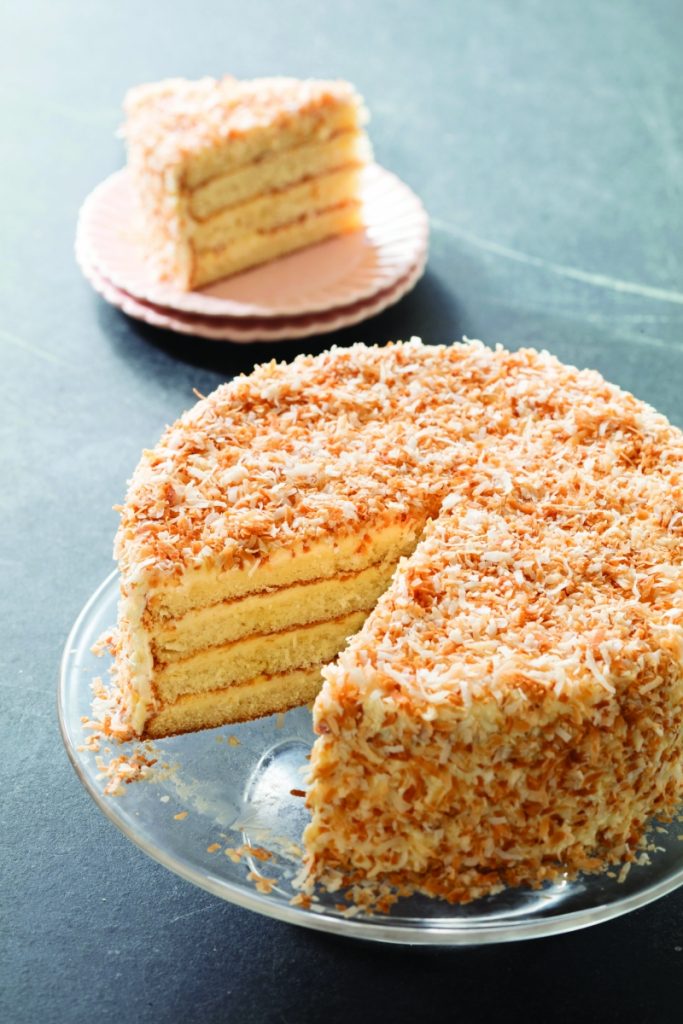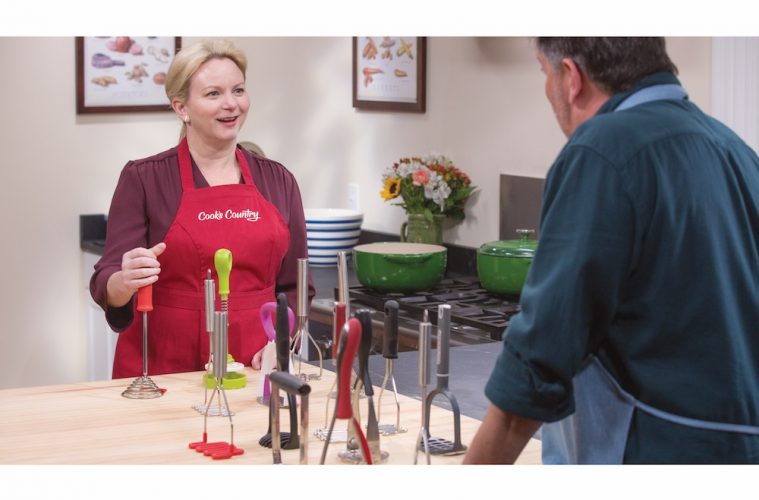Santa Claus always eats very well at the Lancaster home in Marblehead. For starters, the kids leave a plate of some of the best home-baked cookies around—brown-butter chocolate chip and triple coconut macaroons are favorites. No surprise there, since mom Bridget Lancaster has devoted her career to teaching people how to cook on America’s Test Kitchen. But Santa sometimes orders something more substantial, like a meal and a beer, homemade by Lancaster and her husband, Stephen Lancaster, chef at Hawthorne-by-the-Sea in Swampscott.
“Santa knows how to get in touch with us when he wants a sandwich or a nice cold home brew or a big glass of wine,” says Lancaster with a laugh. “After all, Santa isn’t driving. Rudolph is the designated driver—despite his red nose!”
Santa isn’t the only one gearing up for a busy season. Lancaster was home only about eight days in the whole month of October, on tour for a new book written with Julia Collin Davison, who is her co-host at the two long-running PBS series America’s Test Kitchen and Cook’s Country. The pair took the lead roles at the beginning of the year, after nearly two decades in the cast, assuming the mantle from founding host and star Christopher Kimball. Lancaster is also the voice behind the weekly America’s Test Kitchen radio show/podcast.
The cookbook is Lancaster’s first—and it’s a bit surreal, she says, to see her photo on the front. Cooking at Home with Bridget and Julia is a delightful mix of the two authors’ warm personalities and the practical recipes that are the basis of the America’s Test Kitchen brand, offering insight into the recipes Lancaster and Davison turn to when not on camera.
“People always ask, ‘What do you make at home?’” Lancaster says. The answer boiled down to 150 favorite recipes from the Test Kitchen archives, half from each author, that they cook at home, along with personal anecdotes.
“These are the meals we come back to again and again,” Lancaster says. While some of the recipes are special once-a-year dishes, many, like Paella on the Grill, a summer favorite whether she is entertaining or not, and Pasta e Ceci, great on a winter weeknight, are regular staples in the Lancaster home.
“We make Pasta e Ceci a lot,” Lancaster says. “The chickpeas and the little ditalini noodles and the brothy tomato goodness—it sticks to your ribs.”
Having started with America’s Test Kitchen as a test cook in 1998, Lancaster has prepared countless recipes through the years—but for a selection of those dishes to make it from the TV kitchen to her home kitchen takes a bit of magic.
“It’s like finding that spark, when you find that special someone—food is a little like that,” she says. “You’ll find that recipe that either means something to you, or it’s original. There are a lot of memories tied into food as well. I think sometimes when we eat something, it jogs a good memory of what happened that day or it takes us back to a simpler time.”
But it’s not all romance in Lancaster’s Marblehead kitchen—with a demanding career, a chef husband, and two hungry boys, home cooking these days leans toward the practical. “As our schedules change and our kids get older, our expectations of food change,” she says. “On weeknights I tend to do a lot more simple food than for a Sunday night meal.”
Lancaster also has what she calls “cook days,” when she prepares several meals, or at least parts of several meals, at once. “I’ll have the oven on for a roast chicken. But I’ll also throw in a pork tenderloin or two and slice it the next day for salads.… If I’m already in the kitchen, I might as well put a stew in the oven for the next day.… It’s so much easier to think of it that way.”
That same philosophy holds true at the holidays—while there is no getting around the masses of prep work for a proper Thanksgiving dinner, by early October Lancaster had already baked the cornbread for her beloved stuffing, and made the gravy and the pie dough—all were waiting in the freezer.
“If I don’t start now, I’ll be panicking. And you don’t want to panic over the holidays,” she says. “Happy mom, happy holiday.” Advance preparation enables Lancaster to enjoy Christmas traditions in the town the West Virginia native has called home since 1999. “I love that Santa arrives on a lobster boat,” she says, adding that her family delights in the Christmas Walk every year—not to mention giving neighbors platters of Millionaire’s Shortbread, other cookies, and perhaps some of that home brew or a well-fortified homemade eggnog.
In order to make all the festivities possible without going crazy, Christmas lunch has become a make-ahead affair. “We used to do a big roast, and I’d be in the kitchen the entire day,” giving her husband (who as a professional chef rarely gets a holiday) the day off. But now the Christmas Day meal tends more toward Beef Burgundy or short ribs—elegant entrees that can be mostly prepared the day before. “It’s the biggest thing I’ve done to take the load off of myself,” Lancaster says.
One thing that rarely changes is dessert; Lancaster has made the Cook’s Illustrated pecan pie every year since before she started working for the company. And her freezer is packed with many kinds of cookie dough, just waiting to be rolled out, sliced, or stamped and baked. But towering over it all is usually the coconut layer lake. “That is the centerpiece of just about every holiday meal,” Lancaster says. “It is a triple-coconut whammy,” with sweetened flaked coconut, a hint of coconut extract, and cream of coconut, which goes into the wet ingredients. “I do love a good coconut cake. I think it’s the southern part of me.”

Photo by Daniel J. van Ackere
?
RECIPE
Coconut Layer Cake
Reprinted with permission from Cooking at Home with Bridget and Julia, Copyright © 2017 by the Editors at America’s Test Kitchen
Serves 10 to 12
Cake Ingredients
> 1 large egg plus 5 large whites
> 3/4 cup cream of coconut
> 1/4 cup water
> 1 teaspoon vanilla extract
> 1 teaspoon coconut extract
> 2 1/4 cups (9 ounces) cake flour
> 1 cup (7 ounces) sugar
> 1 tablespoon baking powder
> 3/4 teaspoon salt
> 12 tablespoons unsalted butter, cut into 12 pieces and softened
> 2 cups (6 ounces) sweetened shredded coconut
Icing ingredients
> 4 large egg whites
> 1 cup (7 ounces) sugar
> 1 pound (4 sticks) unsalted butter, each stick cut into 6 pieces and softened
> Pinch salt
> 1/4 cup cream of coconut
> 1 teaspoon coconut extract
> 1 teaspoon vanilla extract
DIRECTIONS
1. For the cake: Adjust oven rack to lower-middle position and heat oven to 325 degrees. Grease two 9?inch round cake pans, line with parchment paper, grease parchment, and flour pans. Whisk egg and whites together in large liquid measuring cup. Whisk in cream of coconut, water, vanilla, and coconut extract.
2. Mix flour, sugar, baking powder, and salt in bowl of stand mixer. Using paddle on low speed, beat in butter, 1 piece at a time, until only pea-size pieces remain, about 1 minute. Add half of egg mixture, increase speed to medium-high, and beat until light and fluffy, about 1 minute. Reduce speed to medium-low, add remaining egg mixture, and beat until incorporated, about 30 seconds. Give batter final stir by hand.
3. Divide batter evenly between prepared pans, smooth tops, and gently tap pans on counter to settle batter. Bake cakes until toothpick inserted in centers comes out clean, about 30 minutes, rotating pans halfway through baking.
4. Let cakes cool in pans for 10 minutes. Remove cakes from pans, discard parchment, and let cool completely on wire rack, about 2 hours. (Cakes can be stored at room temperature for up to 1 day or frozen for up to 1 month; defrost cakes at room temperature.) Meanwhile, spread shredded coconut on rimmed baking sheet and toast in oven until shreds are mix of golden brown and white, 15 to 20 minutes, stirring 2 or 3 times; let cool.
5. For the icing: Combine egg whites, sugar, and salt in bowl of stand mixer and set over medium saucepan filled with 1 inch of barely simmering water (do not let bottom of bowl touch water). Cook, whisking constantly, until mixture is opaque and registers 120 degrees, about 2 minutes.
6. Remove bowl from heat. Using whisk on high speed, whip egg white mixture until glossy, sticky, and barely warm (80 degrees), about 7 minutes. Reduce speed to medium-high and whip in butter, 1 piece at a time, followed by cream of coconut, coconut extract, and vanilla, scraping down bowl as needed. Continue to whip at medium-high speed until combined, about 1 minute.
7. Using long serrated knife, cut 1 horizontal line around sides of each layer; then, following scored lines, cut each layer into 2 even layers.
8. Line edges of cake platter with 4 strips of parchment paper to keep platter clean, and place small dab of frosting in center of platter to anchor cake. Place 1 cake layer on platter. Spread 3/4 cup frosting evenly over top, right to edge of cake. Top with second cake layer and press lightly to adhere. Repeat with more frosting and remaining cake layers. Spread remaining frosting evenly over top and sides of cake. To smooth frosting, run edge of offset spatula around cake sides and over top. Sprinkle top of cake evenly with toasted coconut, then press remaining toasted coconut into sides of cake. Carefully remove parchment strips before serving. (Frosted cake can be refrigerated for up to 1 day; bring to room temperature before serving.)

